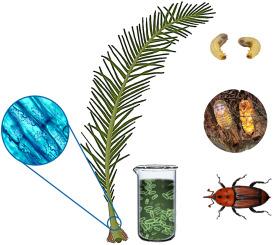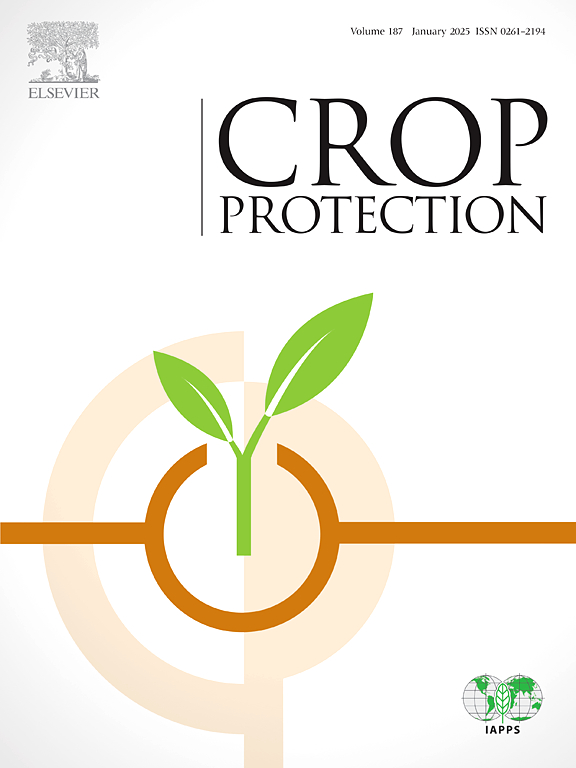Dual-strategy approach for Rhynchophorus ferrugineus control: Endophytic Beauveria bassiana and Bacillus thuringiensis topical application
IF 2.5
2区 农林科学
Q1 AGRONOMY
引用次数: 0
Abstract
In an innovative approach to biological pest management, the entomopathogenic efficacy of endophytically colonized Beauveria bassiana and topically applied Bacillus thuringiensis was evaluated against various larval instars (2nd, 4th, and 6th) of the red palm weevil (RPW), Rhynchophorus ferrugineus. Initially, date palm leaf petioles were inoculated with five distinct isolates of the fungus to ascertain their endophytic potential over two years. Subsequently, the most proficiently colonized fungal isolate was selected for subsequent experimentation. During individual entomopathogen applications, larval instars of RPW were presented with plant petioles and colonized with fungus at 30 days post-inoculation or immersed in bacterial inoculum. Ιn combined treatments, larvae were exposed to both entomopathogen-treated plant petioles concurrently. The tested bacterium was administered at three concentrations (30, 40, and 50 μg/ml). Larval mortalities were markedly lower in treatments involving individual entomopathogens, whereas integrated applications yielded higher mortalities. Treatments associated with heightened larval mortalities corresponded to diminished pupation, adult emergence, and egg eclosion rates. Furthermore, the simultaneous application of both entomopathogens bolstered larval mortalities of RPW both additively and synergistically, with concentration also playing an important role. Similarly, the developmental periods of various insect stages were substantially influenced by combined entomopathogen applications. The inherent prevalence of these pathogens and their ability to colonize crop plants internally for extended periods render them promising agents against cryptic-feeding insects like RPW. However, further evaluation of suitable entomopathogen strains and optimal doses under field conditions is imperative before formulating concrete recommendations for date palm growers.

采用双重策略控制铁线蝇(Rhynchophorus ferrugineus):内生菌Beauveria bassiana和苏云金芽孢杆菌的局部应用
采用一种创新的生物害虫管理方法,评估了内生菌群的 Beauveria bassiana 和局部施用的苏云金芽孢杆菌对红掌象鼻虫(RPW)不同幼虫龄期(2龄、4龄和 6龄)的昆虫致病效果。最初,在枣椰叶柄上接种五种不同的真菌分离物,以确定它们在两年内的内生潜力。随后,选出定殖能力最强的真菌分离株进行后续实验。在施用单个昆虫病原体的过程中,将 RPW 的幼虫龄期与植物叶柄放在一起,并在接种后 30 天用真菌定殖或浸泡在细菌接种物中。在联合处理中,幼虫同时接触两种昆虫病原体处理过的植物叶柄。受试细菌的浓度有三种(30、40 和 50 μg/ml)。在使用单个昆虫病原体的处理中,幼虫死亡率明显较低,而综合使用则会产生较高的死亡率。幼虫死亡率升高的处理方法与蛹化率、成虫出现率和虫卵孵化率降低相对应。此外,同时施用这两种昆虫病原体会以叠加和协同的方式提高 RPW 的幼虫死亡率,浓度也起着重要作用。同样,联合施用昆虫病原体对不同昆虫阶段的发育期也有很大影响。这些病原体固有的普遍性及其在作物植株内部长期定殖的能力,使其成为防治 RPW 等隐蔽性食虫的有效药剂。不过,在为枣椰树种植者提出具体建议之前,必须进一步评估合适的昆虫病原体菌株和田间条件下的最佳剂量。
本文章由计算机程序翻译,如有差异,请以英文原文为准。
求助全文
约1分钟内获得全文
求助全文
来源期刊

Crop Protection
农林科学-农艺学
CiteScore
6.10
自引率
3.60%
发文量
200
审稿时长
29 days
期刊介绍:
The Editors of Crop Protection especially welcome papers describing an interdisciplinary approach showing how different control strategies can be integrated into practical pest management programs, covering high and low input agricultural systems worldwide. Crop Protection particularly emphasizes the practical aspects of control in the field and for protected crops, and includes work which may lead in the near future to more effective control. The journal does not duplicate the many existing excellent biological science journals, which deal mainly with the more fundamental aspects of plant pathology, applied zoology and weed science. Crop Protection covers all practical aspects of pest, disease and weed control, including the following topics:
-Abiotic damage-
Agronomic control methods-
Assessment of pest and disease damage-
Molecular methods for the detection and assessment of pests and diseases-
Biological control-
Biorational pesticides-
Control of animal pests of world crops-
Control of diseases of crop plants caused by microorganisms-
Control of weeds and integrated management-
Economic considerations-
Effects of plant growth regulators-
Environmental benefits of reduced pesticide use-
Environmental effects of pesticides-
Epidemiology of pests and diseases in relation to control-
GM Crops, and genetic engineering applications-
Importance and control of postharvest crop losses-
Integrated control-
Interrelationships and compatibility among different control strategies-
Invasive species as they relate to implications for crop protection-
Pesticide application methods-
Pest management-
Phytobiomes for pest and disease control-
Resistance management-
Sampling and monitoring schemes for diseases, nematodes, pests and weeds.
 求助内容:
求助内容: 应助结果提醒方式:
应助结果提醒方式:


